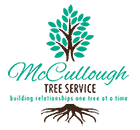By: Shelby McCullough| Published: June 15, 2024
Trees are vital to our environment, providing beauty, shade, and habitat for wildlife. However, not all trees are safe, and some can pose significant risks. It’s essential to identify and manage dangerous trees to prevent property damage or personal injury. This blog post will guide you on how to spot a dangerous tree, ensuring your safety and the health of your yard.
Understanding Dangerous Trees
A dangerous tree, often called a hazardous tree, is one that has structural defects which may cause it to fail in whole or in part. This failure can result in property damage, personal injury, or even death. Recognizing the signs of a dangerous tree early can save lives and prevent costly repairs.

Common Signs of a Dangerous Tree
Identifying a dangerous tree involves looking for specific signs that indicate potential failure. Here are the most common indicators:
- Leaning Trees
- Description: Trees that are leaning significantly to one side.
- Risk: Indicates a root or trunk issue, making the tree unstable.
- Action: Consult an arborist immediately if the lean has developed recently.
- Cracks and Splits
- Description: Visible cracks or splits in the trunk or major branches.
- Risk: These can weaken the tree structure, leading to breakage.
- Action: Have these trees inspected by a professional.
- Dead or Falling Branches
- Description: Branches that are dead, dying, or falling.
- Risk: Dead branches can fall unexpectedly, posing a danger.
- Action: Regular pruning by a certified arborist can mitigate this risk.
- Root Problems
- Description: Visible root damage, soil heaving, or fungus growth near the base.
- Risk: Roots are crucial for stability; damage here can mean the tree is unsafe.
- Action: Address root issues immediately with professional help.
- Hollow Trunks
- Description: Cavities or hollows in the trunk.
- Risk: A hollow trunk can compromise the tree’s strength.
- Action: Hollow trees need evaluation by an expert to determine their safety.

How to Inspect Your Trees
Regular tree inspections can help identify problems early. Here’s how you can inspect your trees for signs of danger:
- Visual Inspection
- Method: Walk around your tree, looking at the trunk, branches, and leaves.
- Focus Points: Look for cracks, splits, leaning, and dead branches.
- Root Check
- Method: Examine the ground around the base of the tree.
- Focus Points: Check for visible roots, soil movement, and fungal growth.
- Professional Assessment
- Method: Hire a certified arborist for a detailed inspection.
- Focus Points: Arborists use specialized tools and knowledge to assess tree health.
Why Regular Tree Care Matters
Regular tree care can prevent many issues that lead to dangerous trees. Here’s why maintaining your trees is crucial:
- Promotes Health: Regular pruning and care keep trees healthy, reducing disease risk.
- Enhances Safety: Removing dead or weak branches prevents accidents.
- Aesthetic Value: Well-maintained trees enhance the beauty of your property.
- Property Value: Healthy trees can increase the value of your property.

Steps to Take If You Identify a Dangerous Tree
If you suspect a tree on your property is dangerous, take these steps immediately:
- Avoid the Area
- Ensure that no one goes near the tree until it has been assessed.
- Contact a Professional
- Reach out to a certified arborist for an inspection.
- Plan for Removal or Treatment
- Follow the arborist’s recommendations, which may include pruning, treatment, or removal.
FAQs about Dangerous Trees
Q: How can I tell if a tree is dead or just dormant?
- A: Check for signs of life such as budding in spring or green tissue under the bark. If unsure, consult an arborist.
Q: Can a leaning tree be saved?
- A: It depends on the cause and severity. An arborist can often stabilize a slightly leaning tree, but severe cases may require removal.
Q: How often should I inspect my trees?
- A: Regular inspections should be done annually, but after severe weather events, additional checks are advisable.
Q: What should I do if a large branch falls?
- A: Clear the area and contact a professional to assess any remaining risks and handle the cleanup.
Q: Are all fungi on trees harmful?
- A: Not all fungi are harmful, but some can indicate decay. It’s best to have any fungal growths inspected by an arborist.
Q: How can I find a certified arborist?
- A: Search for certified arborists through professional organizations like the International Society of Arboriculture (ISA) or local tree care companies.
Q: What’s the cost of removing a dangerous tree?
- A: The cost varies based on the tree’s size, location, and condition. Obtaining multiple quotes from reputable tree service companies is advisable.
Regular tree care and prompt attention to signs of danger are crucial for maintaining a safe and beautiful yard. By following these guidelines, you can ensure the health of your trees and the safety of your property. Remember, when in doubt, always consult a certified arborist to assess and address tree hazards professionally.

